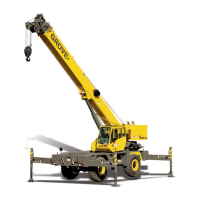Manitowoc Published 07-19-16, Control # 249-01 1-59
2250 SERVICE/MAINTENANCE MANUAL INTRODUCTION
Gantry Cylinders
See Figure 1-35 and Figure 1-36 for the following.
The gantry cylinders partially raise and lower the gantry.
Boom hoist rigging continues raising or lowering the gantry
from or back to this position. See Crane Assembly and
Rigging Guide in the Operator Manual for the gantry raising
and lowering procedure.
With the engine running, power is available to the jacking
remote control when the cable is connected at the auxiliary
valve junction box on the right side of the rotating bed.
Gantry Cylinders Extend
When the power button is pressed and the gantry cylinders
switch is held in the UP (extend) position, an input voltage is
sent to the PC. The PC sends a 12 V output signal to the
auxiliary system’s disable-relief valve HS-12 that adjusts
system pressure to 276 bar (4,000 psi).
The PC also sends a 12 V output signal to enable the gantry
cylinders extend solenoid HS-4. Hydraulic pilot pressure at
24 bar (350 psi) or 21 bar (300 psi) shifts the valve in the
selected direction. Fluid from the auxiliary pump flows past
the auxiliary system’s disable-relief valve HS-12 and enters
the upper accessory valve.
Hydraulic fluid leaves the upper accessory valve and flows
through the free-flow check valve sections of the
counterbalance valves, entering the piston end of the gantry
cylinders, and extends the cylinders to raise the gantry.
Fluid from the rod end of the cylinders is blocked by the free-
flow check valve sections of the counterbalance valves and
flows through the flow-restraining section that has a relief
setting of 241 bar (3,500 psi). The counterbalance valves
serve as a deceleration control, with a 3:1 pilot ratio of the
relief pressure. Hydraulic fluid then exits the counterbalance
valves and passes through the upper accessory valve before
returning to the tank.
If more power is needed to raise the gantry cylinders, engine
speed can be increased with the remote engine speed
switch in the remote start junction box on the right side of the
rotating bed.
When the power button or the gantry cylinder switch is
released, fluid to the gantry cylinders is stopped. The free-
flow check valve sections trap the fluid in the rod and piston
ends of the cylinders to lock the gantry in position.
When the power button or gantry switch is moved to the OFF
position, the PC sends a 0 V output to shift the spool of
solenoid HS-4 to the center position.
Gantry Cylinders Retract
When the power button is pressed and the gantry cylinders
switch is held in the DOWN (retract) position, an input
voltage is sent to the PC. The PC sends a 12 V output signal
to the auxiliary system’s disable-relief valve HS-12 that
adjusts system pressure to 276 bar (4,000 psi).
The PC also sends a 12 V output signal to enable the gantry
cylinders retract solenoid HS-5. Hydraulic pilot pressure at
24 bar (350 psi) or 21 bar (300 psi) shifts the valve in the
selected direction. Fluid from the auxiliary pump flows past
the auxiliary system’s disable-relief valve HS-12 and enters
the upper accessory valve.
The gantry cylinder valve shifts to direct fluid through the
free-flow check valve sections to the rod end of the gantry
cylinder. The gantry lower weight increases the pressure in
the piston end of the cylinders. The exit of the fluid out of the
cylinders is blocked by the free-flow check valve sections
and flows through the flow-restraining section that has a
relief setting of 241 bar (3,500 psi), allowing the valves to
open and controlling the flow out of the cylinders.
Maintaining a back pressure on the piston end of the
cylinders prevents the gantry from falling or lowering faster
than the supply of fluid. Hydraulic fluid returns to the tank
through the gantry cylinder solenoid valve as the gantry
lowers.
When the power button or gantry cylinder switch is released,
the PC sends a 0 V output to shift the spool of solenoid valve
HS-5 to the center position. Fluid to the gantry cylinders is
stopped. Free-flow check valve sections trap the fluid in the
rod and piston ends of the cylinders to lock the gantry in
position.
